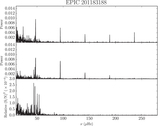Systematics-insensitive Periodic Signal Search with K2
Abstract
From pulsating stars to transiting exoplanets, the search for periodic signals in K2 data, Kepler’s two-wheeled extension, is relevant to a long list of scientific goals. Systematics affecting K2 light curves due to the decreased spacecraft pointing precision inhibit the easy extraction of periodic signals from the data. We here develop a method for producing periodograms of K2 light curves that are insensitive to pointing-induced systematics; the Systematics-insensitive Periodogram (SIP). Traditional sine-fitting periodograms use a generative model to find the frequency of a sinusoid that best describes the data. We extend this principle by including systematic trends, based on a set of “eigen light curves,” following Foreman-Mackey et al., in our generative model as well as a sum of sine and cosine functions over a grid of frequencies. Using this method we are able to produce periodograms with vastly reduced systematic features. The quality of the resulting periodograms are such that we can recover acoustic oscillations in giant stars and measure stellar rotation periods without the need for any detrending. The algorithm is also applicable to the detection of other periodic phenomena such as variable stars, eclipsing binaries and short-period exoplanet candidates. The SIP code is available at https://github.com/RuthAngus/SIPK2.
- Publication:
-
The Astrophysical Journal
- Pub Date:
- February 2016
- DOI:
- 10.3847/0004-637X/818/2/109
- arXiv:
- arXiv:1505.07105
- Bibcode:
- 2016ApJ...818..109A
- Keywords:
-
- asteroseismology;
- methods: data analysis;
- methods: statistical;
- stars: rotation;
- techniques: photometric;
- Astrophysics - Solar and Stellar Astrophysics;
- Astrophysics - Earth and Planetary Astrophysics
- E-Print:
- doi:10.3847/0004-637X/818/2/109
